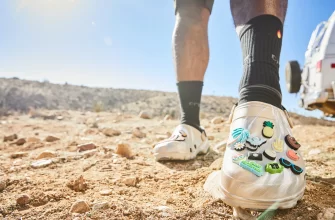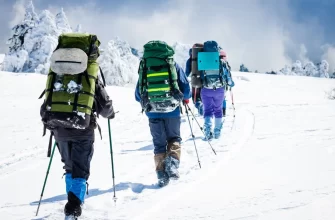To keep us standing when hiking in winter, footwear traction devices are essential. So, you might also be asking what should you choose: crampons vs. microspikes.
We’ll go over the key distinctions between crampons vs. microspikes in this article, as well as when to wear each of these winter traction devices.
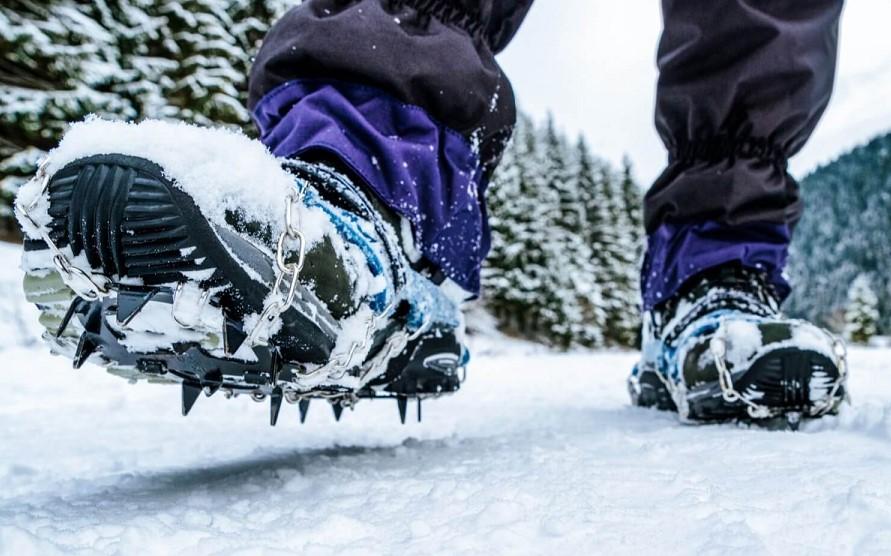
- What are microspikes?
- Different microspikes types
- Usage of microspikes
- When should you use the microspikes?
- What are crampons?
- Different crampons types
- Material
- Binding
- Spikes
- Compatibility
- Usage of crampons
- When should you use crampons?
- What is the difference between crampons and microspikes?
- Crampons vs. microspikes: design
- Crampons vs. microspikes: compatibility
- How do you decide between microspikes and crampons?
- Crampons vs. microspikes: purpose
- Crampons vs. microspikes: usage
- Crampons vs. microspikes: cost
- Can you use crampons instead of microspikes?
- In conclusion
What are microspikes?
In cold weather, traction aids called microspikes are utilized. They normally include between 6 and 10 stainless steel spikes on the bottom to keep you from falling on slick surfaces like icy terrain and snow, as well as a rubber harness that fits around your hiking boots or walking shoes.
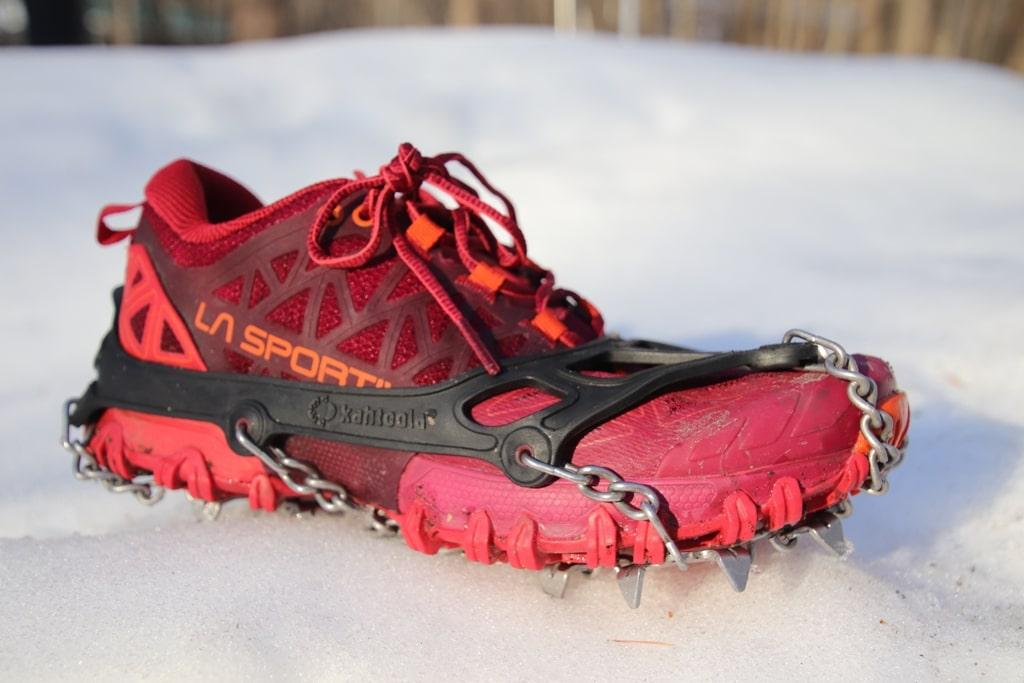
Typically, these spikes measure between 1/4 and 1/2 inches in length. Imagine them as the equivalent of tire chains for your feet.
Both tire chains for vehicles and microspikes for feet increase traction.
There are numerous varieties of microspikes available on the market, with various spike lengths and materials to suit a range of price points.
They are well-liked for all kinds of winter sports, including jogging, strolling, and light mountaineering. You might wish to buy a pair if you live somewhere with a lot of winter weather.
Different microspikes types
Except for a few minor variations, most microspikes are quite identical.
While some only have a chain that goes around the bottom of the boot, others include chains with spikes that range in size from 1/4 to 1/2 inch.
Others only feature a little metal protrusion, resembling a stud, that adds a tiny bit of additional traction.
Usage of microspikes
Microspikes (or, the generic version – ice cleats) may typically be worn over your regular hiking boots or other footwear and are simple to put on and take off. Here are the general procedures for securing microspikes to your shoes or boots:
- Begin by sitting down and slightly inclining your back.
- Match the front tips of the microspikes with the front of your shoe to position the microspikes correctly. The rubber ring or loop of the toe bail should be facing up, and the spikes should be facing the ground.
- Put your shoes on first, then the microspikes (similar to putting on a pair of socks). Wrap the spikes’ back end around your heel.
Utilize a rubber loop toward the heel of your boot to take your microspikes off, much like you would a sock.
If you walk or run normally while wearing your microspikes, you will have the extra traction you need to prevent slipping.
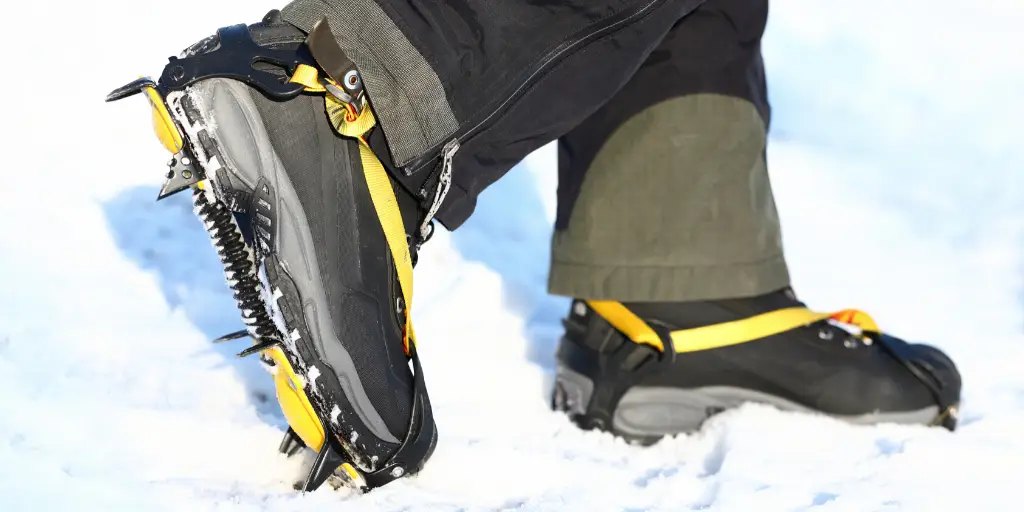
When should you use the microspikes?
If you intend to trek or go hiking across icy terrain, microspikes are an essential safety tool. They give you the traction you need to move across snowy and icy terrain, some sections of hiking routes, and other slick situations.
Even if you are not an experienced hiker, they are an excellent method to provide extra traction on flat surfaces while engaging in daily activities.
Microspikes are a great alternative for folks who want to walk on flat, packed snow-covered trails without wearing heavy snowshoes because they are frequently lightweight and portable.
One thing to keep in mind is that, if you’re traveling by air, you can only bring your crampons and microspikes on the plane in checked luggage.
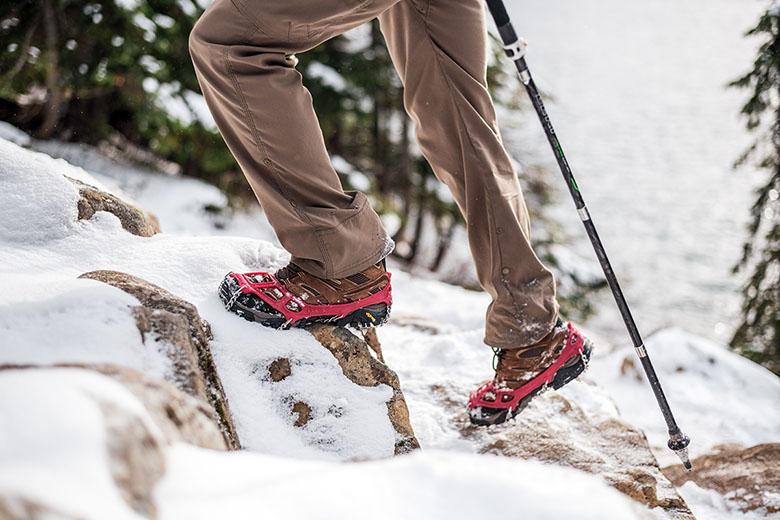
What are crampons?
Hiking crampons are steel or aluminum tools used primarily for negotiating extremely icy terrain and deep snow, such as ascending mountain summits.
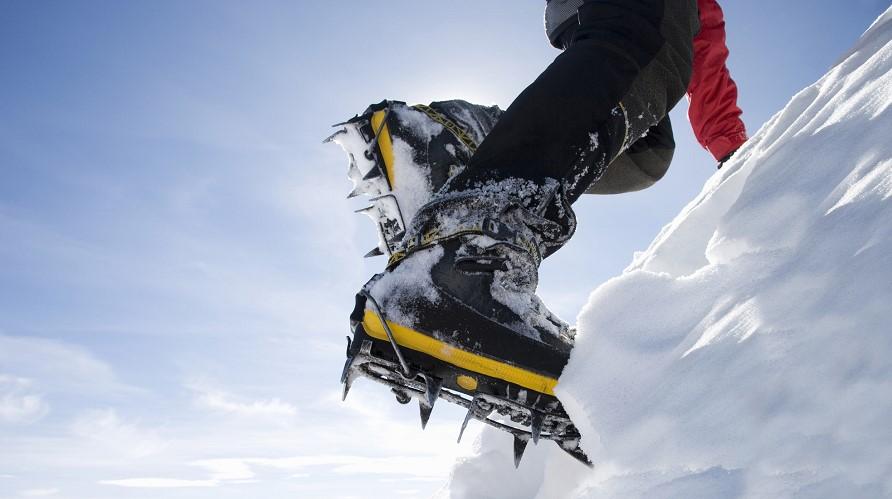
Crampons provide aggressive traction for these difficult hikes up high ice.
They should only be used for ascending steep, icy slopes because they are not meant for everyday trekking.
Crampons have longer spikes, and the material used for the straps is also different (metal for crampons and rubber for microspikes).
Most crampons are used on difficult terrain including glaciers, frozen waterfalls, rocky terrain, steep slopes, and powdery or deep snow areas. Crampons typically have 1- to 2-inch-long spikes.
Different crampons types
Hiking crampons come in a variety of materials, with varying spike counts, binding configurations, and boot compatibility.
Material
Crampons are often composed of either aluminum, which is more lightweight and suitable for alpine climbs, or there are stainless steel crampons, which are very strong and good for technical climbing.
Binding
The majority of mountaineering crampons either have step-in or strap-on binding. For mountaineering boots, step-ins are advised and a very solid sole is needed. Most boots can be worn with strap-ons, which fit over the top of your foot.

Spikes
A crampon’s bottom typically has 10 to 12 points, like Black Diamond contact crampons, for example. A few points point out from your toes and face forward, while others face downward.
Compatibility
Certain crampons can only be fastened to mountaineering boots, whereas others can be attached to virtually any pair of hiking boots.
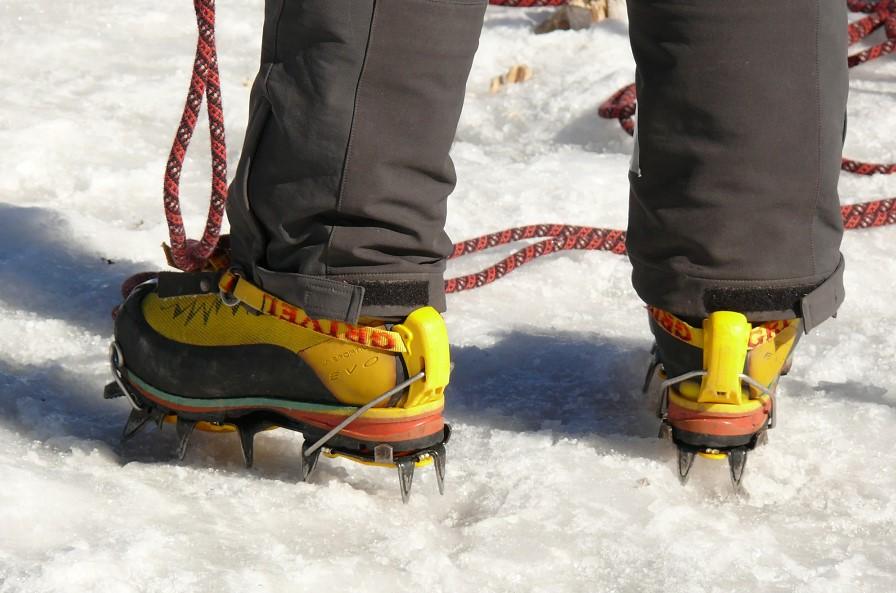
Usage of crampons
Contrary to microspikes, most crampons are more difficult to put on and take off. It might be beneficial to practice putting them on while wearing gloves at home, so you can feel confident doing it in the field.
According to the brand and style, the crampons must be placed in a specific way.
Here are some general pointers for utilizing crampons:
- Make sure your boot laces and crampon straps are tucked in securely.
- Ensure that the crampon frames and the soles of your boots make good contact when you tighten the straps.
When technical ice climbing while wearing crampons, be sure to maintain a wider stance than usual (larger than shoulder width) and keep your knees bent and relaxed.
When you reach a flat area with deep or powdery snow, take off your crampons.
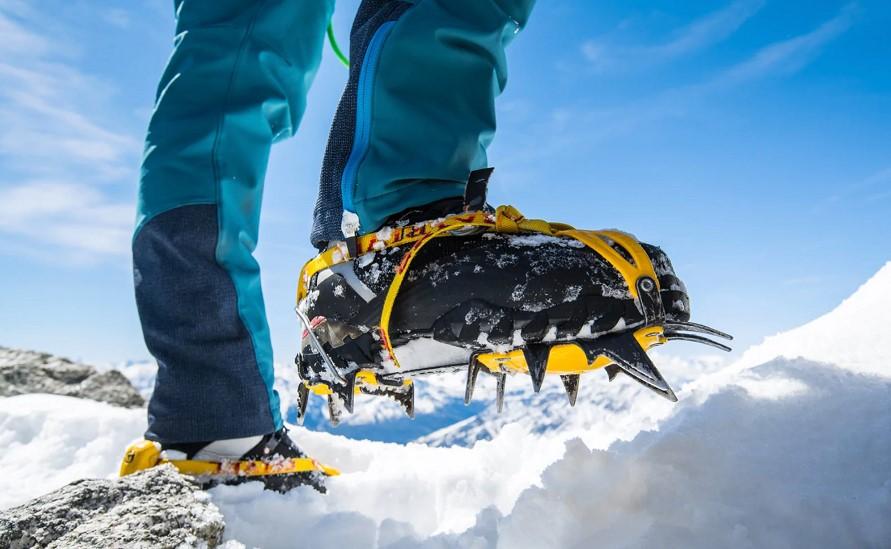
When should you use crampons?
Crampons are an essential piece of equipment for all summit ascents, ice-covered rocks, scaling frozen waterfalls, and other general technical mountaineering.
You shouldn’t undertake any winter activities that require you to traverse ice terrain quickly without crampons.
Make sure you have the right kind of crampons for your safety because it will depend on the terrain and how you utilize them. Ice-climbing crampons are different from ordinary mountaineering crampons.
The design of your hiking boot and the terrain you plan to climb will both have a big impact on how you strap on your crampons.
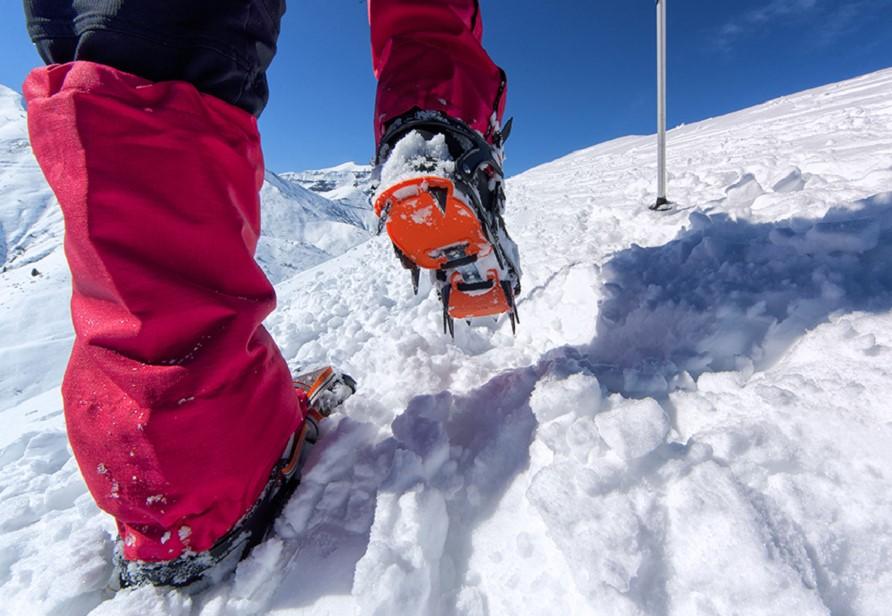
What is the difference between crampons and microspikes?
Both crampons vs. microspikes provide additional traction for moving about on snow and ice. Each of them is made to attach to your climbing or hiking boots. Both use metal spikes to provide a good grip for your footwear in places where rubber wouldn’t do much. These spikes bite into snow and ice.
The similarities stop there, though, pretty much. The construction and situations for which microspikes and crampons are most effective are very different.
Microspikes can’t compete with the aggressive traction offered by crampons. The crampons themselves are more securely fastened to your boots, and the spikes are larger and thicker.
The front-facing spikes on crampons are an important feature because they enable you to kick into steep slopes.
Crampons can be used for a variety of activities, including ice climbing, navigating steep, slippery slopes, and walking on snow-covered routes.
On the contrary, microspikes are virtually entirely made for walking on hard-packed snow slopes and icy trails.
Unlike the points on crampons, their tiny, thin spikes are not as sharp. Some are designed for flat terrain only and don’t have any spikes at all. Also, you cannot kick into steep terrain with microspikes because every spike points downhill.
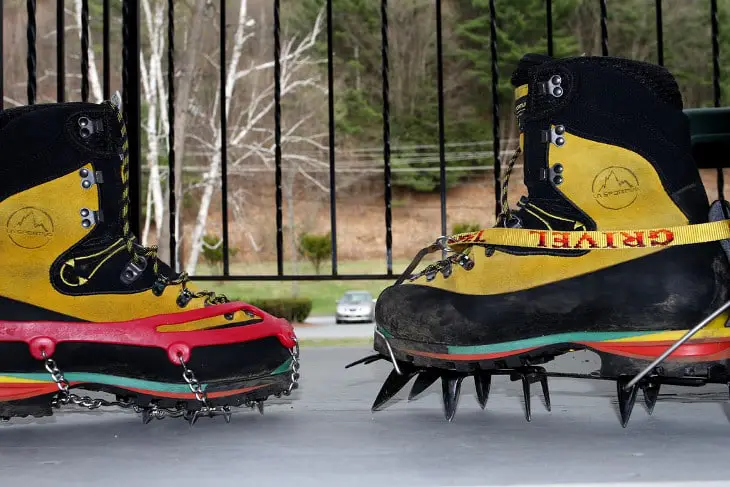
Crampons vs. microspikes: design
The majority of crampons are made with two hard plates that fit beneath your feet’s front and back and a metal bar connecting the two plates. A heel welt, a plastic or metal bar that snaps into place on the heel of your boot, secures the plates to your boot.
By attaching a piece of webbing over the top of your boot, you may then tighten the crampon even further.
Each of the 8–12 spikes on a mountaineering crampon can be up to half an inch long and exceedingly pointed. Significantly, four of these spikes point forward — two directly in front of your toe and two more that angle forward and down on either side of your foot. The remaining spikes all have a downward-facing angle.
A metal chain-attached flexible elastomer harness is used with microspikes. The chains and the associated spikes are held firmly against the bottom of your foot by the rubber harness, which extends over your boot. Microspikes are relatively simple to put on and take off when compared to crampons.
Microspikes often have very tiny points that are no longer than 1/8 of an inch. They all have a downward-pointing slant to provide you with traction. Microspikes typically only have 8–10 points on each foot, and they are not as sharp as crampon spikes.
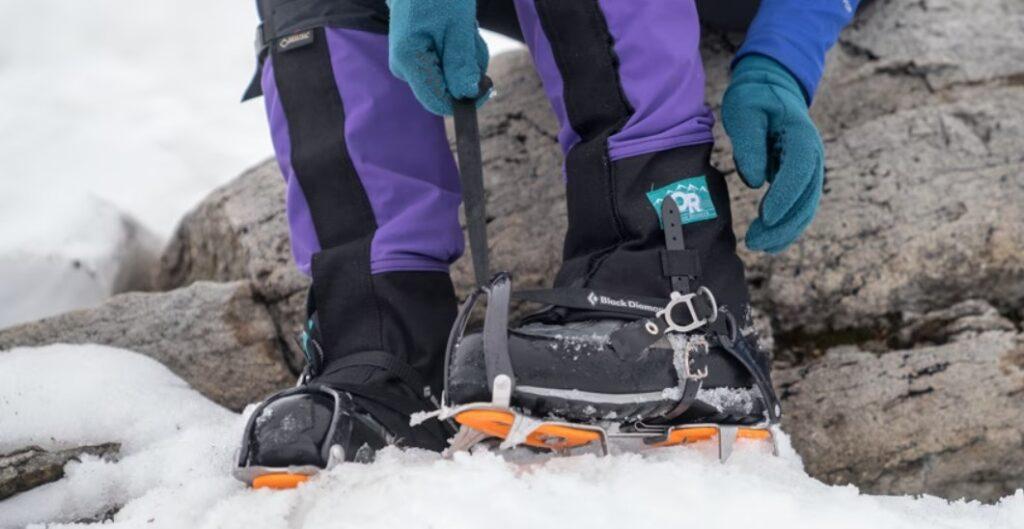
Crampons vs. microspikes: compatibility
The majority of hiking and climbing boots are compatible with microspikes. Simply select the rubber harness size that corresponds to your boot. Running shoes can also be worn with microspikes, although you may need a different size harness than you would for your boots.
There are two distinct crampon varieties, each with unique boot compatibility. Step-in crampons commonly referred to as automated crampons, lock around your boot using the heel welt mechanism.
Your boots must feature a rubber platform on the back that catches the heel welt and holds it in place if you want to utilize step-in crampons. This is a feature of all pairs of climbing boots, but not all pairs of boots.
Contrarily, strap-on crampons can be worn with any boot, even hiking boots. These crampons rely simply on nylon webbing which you tie around your boot, as opposed to using a heel welt. Strap-on crampons shouldn’t be used for steep, demanding ice climbing since they are less secure than step-in crampons.
The majority of crampons are one-size-fits-all, so you won’t need to purchase multiple sets to accommodate boots of various sizes.

How do you decide between microspikes and crampons?
Crampons vs. microspikes: purpose
Because they serve various purposes, crampons and microspikes have different designs. Crampons contain fewer but larger spikes (typically 1″) that penetrate deeply into ice and snow to improve traction. In contrast, microspikes have shorter spikes (1/4″ or 1/2″) as the name suggests. Chains are occasionally used by microspikes to provide traction, but not with crampons.
The thick straps and spaced-out strong spikes on crampons make it easier to go over rough ground, steeper slopes, and deep snowfields. They also facilitate difficult climbing on slippery terrain.
Crampons vs. microspikes: usage
Crampons cannot be used while trekking. Only with them can you climb. Using microspikes for hiking and trekking sports like trail running and backpacking on mildly snowy or icy paths is lighter and more comfortable.
While crampons don’t require any training to operate safely, microspikes must.
Running and jogging are both safe when wearing microspikes, but they should not be done while wearing crampons.

Crampons vs. microspikes: cost
Microspikes are significantly less expensive than crampons. It is not possible to select either microspikes or crampons, though. This is so that they can be employed in a variety of circumstances.
As a result, you ought to get the item that most closely matches your needs. Price shouldn’t serve as the deciding factor if you require both; it is recommended to purchase both.
Can you use crampons instead of microspikes?
Slips on ice, heavy snow and slightly uphill terrain can be avoided with a good pair of inexpensive, lightweight microspikes that are suitable for the majority of snow and ice conditions you will experience regularly.
Only choose crampons for surfaces where microspikes will fall short. These strong traction devices that attach to boots bite into the ice with sharp metal points. Crampons are more suited for steeper, icier terrain, including glacier hiking and even vertical ice climbing because they are heavier than microspikes.
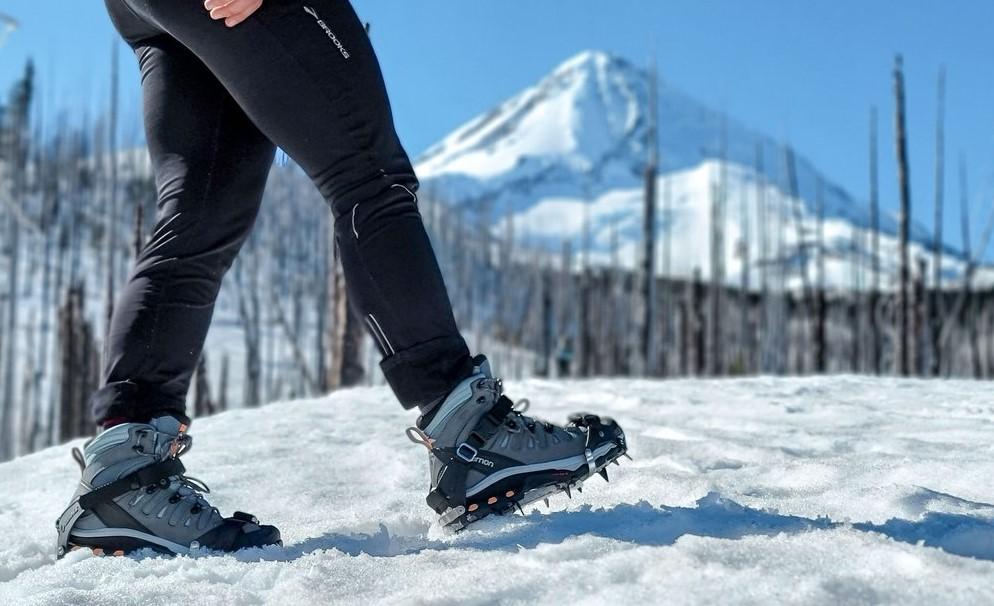
In conclusion
It is important to take into account the aspects of the outdoor activities you will engage in most frequently when deciding between crampons vs. microspikes to satisfy your winter traction device needs.
Crampons are a necessity for mountaineering expeditions that include climbing up steep, icy slopes. Microspikes are more portable and user-friendly for hiking on easy-to-moderate trails.
Read More: Do I Need Microspikes, Crampons, or Snowshoes For My Winter Hike?



![What is considered a long hike? [8 factors to consider] What Is Considered A Long Hike: Top 3 Tips & Best Guide](https://griffithparkhiker.com/wp-content/uploads/2024/01/griffithparkhiker-2-335x220.jpg)




